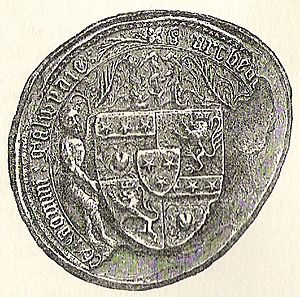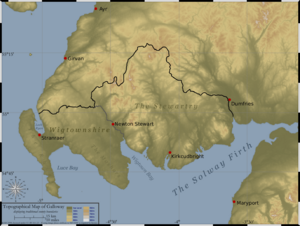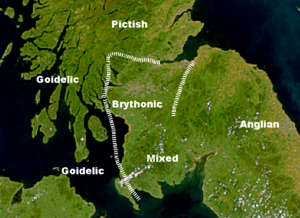Galwegian Gaelic facts for kids
Quick facts for kids Galwegian Gaelic |
|
|---|---|
| Gallovidian Gaelic Gallowegian Gaelic Galloway Gaelic Gaelic Gàidhlig |
|
| Region | Galloway, Annandale, Nithsdale and Carrick, Scotland |
| Extinct | 1760, with the death of Margaret McMurray |
| Language family |
Indo-European
|
| Early forms: |
Primitive Irish
|
| Writing system | Latin script (Scottish Gaelic orthography) |
Galwegian Gaelic was a type of Scottish Gaelic language. It was once spoken in the southwest part of Scotland. People in areas like Galloway and Carrick used this language. Sadly, Galwegian Gaelic is now extinct, meaning no one speaks it anymore. We don't have many records of it today, except for many place-names (names of towns or places). This makes it hard to know exactly how it was related to other Gaelic languages.
Contents
Where Was Galwegian Gaelic Spoken?
For a long time, people in Galloway and Carrick spoke Galwegian Gaelic. This happened as other languages, like an old form of English and a Celtic language called Cumbric, became less common. We know that an early form of Irish Gaelic was spoken in the Rhins of Galloway as far back as the 400s.
It's not fully clear how Gaelic spread in this area. Most experts think that Gaelic was widely spoken by the 1000s. Some even suggest it happened earlier, around the 800s. This change isn't written down in old history books. So, we learn about it from studying place-names.
Early place-names often started with words like Sliabh (meaning "mountain") or Carraig (meaning "rock"). This suggests that Gaelic speakers settled there around the same time as the ancient kingdom of Dál Riata.
The Norse-Gaels Arrive
Later, people called the Gall-Gaidhel settled in the 800s and 900s. Their name means "foreign Gaels." They gave the area its name, Galloway. Many of these settlers had both Norse (Viking) and Gaelic backgrounds. They became Gaelic speakers, which set them apart from other Norse leaders in northern Britain.
It's possible that the Cumbric language was still spoken in areas like Annandale and Nithsdale until the 1100s. But by the end of that century, Gaelic had taken over these areas too. The Cumbric language then disappeared from the region.
Galwegian Gaelic likely reached as far east as the River Annan. This is because Gaelic place-names quickly disappear past that river. To the north, it might have become separate from other Scottish Gaelic dialects by the 1300s or 1200s.
What Was Galwegian Culture Like?

People in medieval Galloway who spoke Gaelic had a strong reputation. Some old English writers even called them "Picts" by mistake. They were seen as very fierce by northern English writers. There were even stories about their brutal actions during raids. For example, it was said that in 1296, Galwegians attacked Hexham Priory. They supposedly damaged a saint's shrine and threw holy items into a fire.
Galloway was a bit separate from the rest of Scotland until 1234. After a big rebellion and the end of the Lordship of Galloway, the region and its people became very important. The Scottish Wars of Independence were even seen by some as a kind of civil war involving Galwegian families.
Clans and Surnames
After 1234, several powerful family groups, or clans, lived in Galloway. These included the MacLellans, MacDowalls, and Kennedys of Carrick. These clans probably helped run society in Galloway during the Middle Ages. Old records show words like cineal (kindred) and muinntir (household). These words show that a clan system was in place.
Many local surnames still have Gaelic roots. Examples include MacDowall, Hannay, McKie, Kennedy, and MacCulloch. Some place-names like Balmaclellan and Balmaghie might show where clan chiefs lived.
Evidence of poets or storytellers (called bards) can also be found in place-names. For example, Dervaird means "oak wood of the bard."
How Was it Related to Other Languages?

Experts believe Galwegian Gaelic was more similar to the Manx language (spoken on the Isle of Man) and Ulster Irish (spoken in northern Ireland). It was probably less like the Scottish Gaelic spoken in the Highlands. However, in the Middle Ages, all Goidelic languages were quite similar. People could likely understand each other across different regions. Some think the Gaelic spoken on the Isle of Arran might have been very similar to Galwegian Gaelic.
English and Norse Influence
Galwegian Gaelic might have borrowed some words from Old English or Norse. For example, the word for "church" in Galwegian place-names is often kirk (from English/Norse). In most other parts of Scotland, the Gaelic word cille was used.
Many place-names in Galloway start with Kirk, followed by a Gaelic word. For example, Kirkcormac or Kirkinner. This is interesting because the word order (Germanic word first, then Gaelic) is usually the opposite in Celtic languages. It might show how much English influenced the dialect.
The popularity of English saints also shows this influence. Kirkcudbright means "Church of St Cuthbert." Another example is Closeburn, which was once called Killeosberne (meaning "Church of Osbern"). Many personal names also show Anglo-Saxon influence. For instance, Gille Cuithbrecht means "devotee of St Cuthbert."
When Did Galwegian Gaelic Disappear?
In the early 1500s, a poem called The Flyting of Dunbar and Kennedy was written. It shows a disagreement between two poets. William Dunbar, from Lothian (English-speaking Scotland), made fun of Walter Kennedy, from Carrick (Gaelic-speaking Scotland). Dunbar called Kennedy's accent "Highland" and his language "Irish." Kennedy defended it, saying it was "all true Scotsmen's language." This poem shows that even in the early 1500s, Carrick and Galloway were still seen as Gaelic-speaking areas.
Another writer, George Buchanan, who spoke Gaelic himself, wrote in 1575 that Gaelic was still spoken in Galloway. An English investigator reported around 1563-1566 that most people in Carrick "speak Irish" (meaning Gaelic).
After this, there is less clear evidence, but it seems the language was spoken, at least in small parts, into the 1700s. Margaret McMurray (who died in 1760) is one of the last known speakers. Some think the linguist Alexander Murray (1775–1813) might have learned it from his father, a local shepherd.
It's generally believed that Galwegian Gaelic died out sometime between 1700 and 1800. Other nearby areas, like the Isle of Man, parts of Ulster, and the Isle of Arran, had native Gaelic speakers into the 1900s.
Modern Influence
Even though Galwegian Gaelic is gone, its history still inspires people. For example, the poet William Neill wrote in Scottish Gaelic, Irish, and Scots. He was inspired by Galloway's Gaelic past. The "Gall-Gael Trust" was also founded to celebrate this heritage.
In 2018, a conference called 'Galloway: Gaelic's Lost Province' was held. This shows that people are still interested in the history of this language.



